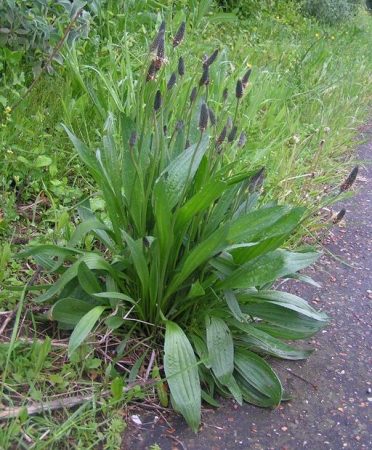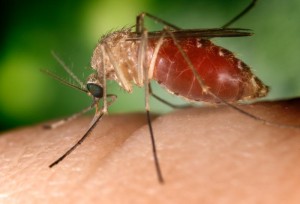This post was written by Lauren Breau, MAcOM, L.Ac. She is founder and executive director of L/A Community Acupuncture.
‘Tis the season of wild strawberries and lobster bakes and body-surfing fat Atlantic waves … but it’s also the season for getting chewed alive by bugs. (If you’ve ever been dive-bombed by a black fly while floating on an inflatable tube designed to resemble an ice cream sandwich, you know exactly what I mean.)
Mosquitoes, biting flies, no-see-ums, and occasionally, the sting from a bee or wasp, all can turn a glorious summer day into a literal suckfest — and even more so if you’re dealing with a small child who’s been snacked upon.
But fear not, as one of the best bug bite remedies is under your feet (like, literally, under your feet). Though it’s typically considered an annoying weed, this herb can soothe a throbbing red welt in a jiffy. It can also pull an embedded splinter to the surface without having to physically restrain a small person. (Ever come at a kid with tweezers? I don’t blame them for their reaction.)
Common Plantain: Herb for stingers, scrapes, sunburns, and slivers
Common plantain is the queen of herbs when it comes to making an on-the-spot poultice to treat the bites and stings of insects. It’s also good for scrapes, sunburns, and slivers.
A poultice is simply plant material that’s been mashed up and applied to the body to relieve inflammation. Making a plantain poultice, especially during this time of the year, is wicked easy!
First, a bit more about plantain (both Plantago major and Plantago lanceolata can be used).
Plantain is a common weed that grows everywhere. It’s a perennial (comes back every year) and can be found almost anywhere in North America. Plantain can be harvested from early spring until the first frosts.
The young leaves are superior when using medicinally (when using plantain topically, the dried herb is useless). Remember to choose your area of harvest with discretion, and consider pesticides and other environmental toxins that are used near well-traveled roads and other areas where there’s an attempt to maintain weeds. (Also, you do not need to worry about over-harvesting plantain).
Need help identifying plantain? Here’s a link that will tell you what you need to know for Maine (don’t worry, it’s super easy). We’ve also got some handy pictures for you to study.

Plantain lanceolata (Ribwort) By sannse [GFDL or CC-BY-SA-3.0], via Wikimedia Commons

Plantago Major By Rasbak (Own work) [GFDL or CC-BY-SA-3.0], via Wikimedia Commons
Making A Poultice
Super simple. Gather a handful of fresh, young leaves. First, rinse them. Then chew them (it’s edible), mash them, or use a mortar and pestle. Do whatever you need to do in order to crush the leaves of the plant so that they release the juice that comes from breaking the cell walls. It’s the juicy mash that will alleviate pain and itching, as well as help draw out stingers or other irritants that are embedded within the skin.
Apply this mash to the affected area and wrap with a cloth. Leave for 30 minutes, and change as necessary (the poultice may turning brownish- blackish and feel warm; if so, time to replace it with a fresh one).
You can also make a plantain tea or infused oil to have on hand.
Plantain is unmatched in its ‘drawing’ properties. To draw out a sliver embedded in the body, make a hot plantain tea (see above link for recipe) and add a couple tablespoons of sea salt. Soak the affected area for 20 minutes. If you don’t have time to make the tea, apply a plantain poultice and wrap the area. Change this a couple of times a day. The sliver will move to the surface, and you’ll better be able to snag it with some pointy tweezers.
Notable constituents found in plantain are allantion, apigenin, baicalein, linoleic acid, vitamin C, vitamin K, and bitters. Plantain is considered anti-inflammatory, antimicrobial, and antihemorrhagic.
A testimonial
A few years ago, my daughter got stung by honeybees in two places on her arm. Sorry, we don’t have any pictures to show you but they were both very swollen and red. She didn’t have any symptoms of an allergic reaction, which can be life-threatening, but her arm hurt like you know what. She foraged for plantain somewhere in Portland (as Lauren said, it’s everywhere) and made a poultice similar to the one Lauren described. She had a cooling feeling immediately and the redness and swelling were down in about 15 minutes.


also Yellow flowered “Touch-me-nots”
Thanks John!